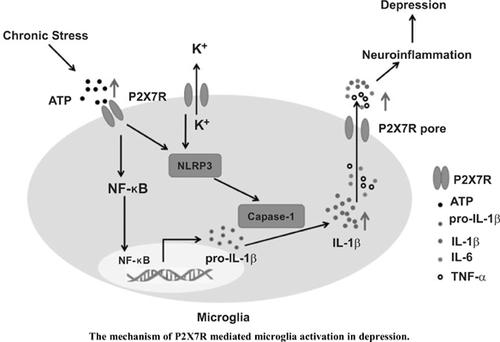Current Drug Targets ( IF 3.0 ) Pub Date : 2021-07-31 , DOI: 10.2174/1389450122666210120141908
Zeyi Huang 1 , Sijie Tan 1

|
重度抑郁症(MDD)是一种常见的精神障碍。虽然遗传、生化和心理因素都与MDD的发生有关,但普遍认为慢性应激引起的脑部一系列病理变化是MDD的主要原因。然而,慢性压力引起的 MDD 的具体机制在很大程度上被破坏了。最近的研究发现,脑内小胶质细胞促炎细胞因子的增加和炎症通路的变化是 MDD 的潜在病理生理机制。P2X7 受体 (P2X7R) 及其介导的信号通路在小胶质细胞激活中起关键作用。本综述旨在展示和讨论有关 P2X7R 在 MDD 中作用的累积数据。首先,我们总结了 P2X7R 与 MDD 相关性的研究进展。随后,我们介绍了 MDD 中 P2X7R 介导的小胶质细胞激活以及 P2X7R 在由慢性压力引起的血脑屏障 (BBB) 通透性增加中的作用。最后,我们还讨论了慢性压力后 P2X7R 表达变化的潜在机制。总之,P2X7R 是调节小胶质细胞活化的关键分子。慢性应激通过分泌白细胞介素-1β(IL-1β)等炎症细胞因子激活海马小胶质细胞,增加血脑屏障通透性,从而促进MDD的发生和发展,表明P2X7R可能是MDD的一个有前景的治疗靶点。我们展示了 MDD 中 P2X7R 介导的小胶质细胞激活以及 P2X7R 在由慢性压力引起的血脑屏障 (BBB) 通透性增加中的作用。最后,我们还讨论了慢性压力后 P2X7R 表达变化的潜在机制。总之,P2X7R 是调节小胶质细胞活化的关键分子。慢性应激通过分泌白细胞介素-1β(IL-1β)等炎症细胞因子激活海马小胶质细胞,增加血脑屏障通透性,从而促进MDD的发生和发展,表明P2X7R可能是MDD的一个有前景的治疗靶点。我们展示了 MDD 中 P2X7R 介导的小胶质细胞激活以及 P2X7R 在由慢性压力引起的血脑屏障 (BBB) 通透性增加中的作用。最后,我们还讨论了慢性压力后 P2X7R 表达变化的潜在机制。总之,P2X7R 是调节小胶质细胞活化的关键分子。慢性应激通过分泌白细胞介素-1β(IL-1β)等炎症细胞因子激活海马小胶质细胞,增加血脑屏障通透性,从而促进MDD的发生和发展,表明P2X7R可能是MDD的一个有前景的治疗靶点。P2X7R 是调节小胶质细胞活化的关键分子。慢性应激通过分泌白细胞介素-1β(IL-1β)等炎症细胞因子激活海马小胶质细胞,增加血脑屏障通透性,从而促进MDD的发生和发展,表明P2X7R可能是MDD的一个有前景的治疗靶点。P2X7R 是调节小胶质细胞活化的关键分子。慢性应激通过分泌白细胞介素-1β(IL-1β)等炎症细胞因子激活海马小胶质细胞,增加血脑屏障通透性,从而促进MDD的发生和发展,表明P2X7R可能是MDD的一个有前景的治疗靶点。

"点击查看英文标题和摘要"































 京公网安备 11010802027423号
京公网安备 11010802027423号